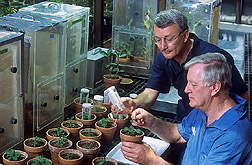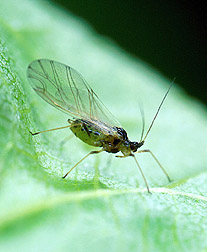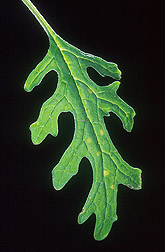A Pox on That Virus!
|
|
|
|
Plum pox potyvirus (PPV) is a devastating disease of wild and cultivatedPrunus species, which include plums, peaches, apricots, nectarines, and many other stone fruits. The disease manifests as yellow rings and blotches on leaves or fruit. Although not a danger to consumers, PPV can ruin the fruit's marketability by increasing acidity and causing deformities.
In Europe, 100 million trees are infected, and PPV has made a small but worrisome foray into the United States, limited so far to several orchards in and around Adams County, Pennsylvania. But plant scientists haven't been completely caught off guard. Since 1991, four USDA scientists—Vernon Damsteegt, Laurene Levy, Ann Callahan, and Ralph Scorza—have conducted basic research in anticipation of just such an invasion, including development of a transgenic plum tree that resists the virus (see story on page 11). |
|
|
When and how PPV entered the United States remains speculative. But shortly after its presence was announced in October 1999, the team's work took on new urgency, says Damsteegt, a plant pathologist with ARS' Foreign Disease-Weed Science Laboratory at Fort Detrick, Maryland, about a 45-minute drive from the infected Pennsylvania orchards.
Cooperative ties were soon forged with research teams at Pennsylvania State University (PSU), the Pennsylvania Department of Agriculture (PDA), and groups in Europe. Levy, one of the first to confirm the disease, is a plant virologist with USDA's chief regulatory arm, the Animal and Plant Health Inspection Service (APHIS), in Beltsville, Maryland. Scorza, a horticulturist, and Callahan, a geneticist, are both assigned to another ARS lab. When PPV emerged in Pennsylvania, APHIS quarantined all stone fruit trees, seed, budwood, and nursery stock in a 4-square-mile Adams County area to keep PPV from escaping via plant material bound for other U.S. stone fruit regions. Over 1,000 acres of stone fruit trees have been destroyed so far, with grower indemnities totaling $12 million, reports Stephen Poe, an APHIS domestic and emergency operations officer. |
|
|
Plotting Against Plum Pox
The PPV research focuses on six fronts: epidemiology, herbaceous weed host identification, wild and ornamentalPrunus species susceptibility, insect transmission, molecular detection and characterization, and disease resistance in cultivatedPrunus crops. Eradicating PPV from the Adams County area is the ultimate goal, "one that we should be able to achieve in the next few years," says Poe. Even then, scientists aren't taking any chances. They're building a body of knowledge that U.S. stone fruit growers can draw on to cope with the disease if it recurs. "If we could eradicate the pathogen, it would be a historic achievement," says Frederick Gildow, a professor at PSU's Plant Pathology Department who assists with the collection, rearing, and study of insects known to spread PPV. But "it's likely that there could be future invasions of this virus. By doing the research now, we'll all be better prepared for the next time around." Culprit and Accomplice Their target is strain D—one of four PPV serogroups (D, M, C, and EA) that plague stone fruits and otherPrunus species in Europe, the Mediterranean, Balkan States, Middle East, India, Chile, Canada, and elsewhere. Strain D is less aggressive than the others and is the only PPV strain reported in North America, notes Levy. She and Vessyla Mavrodieva, a postdoctoral scientist from Bulgaria, have sequenced the genomes of two strain D specimens isolated from an Adams County peach and plum tree. Andrew Stone, a biologist at ARS' Fort Detrick lab, is sequencing a third isolate from the same area for comparison. PPV is transmitted by aphids—small, teardrop-shaped insects with a sharp mouthpart called a stylet for sucking out plant sap. About 20 aphid species worldwide are known to transmit PPV toPrunus plants. Since spring 2000, Pennsylvania entomologists Jim Stimmel and Greg Krawczyk have conducted extensive surveys of orchards in Adams and neighboring counties, identifying the aphid species that live there. Gildow and Damsteegt have begun studies to examine these insects' ability to transmit Pennsylvania strain D. One Adams County accomplice they've fingered is the green peach aphid,Myzus persicae. Inside the ARS quarantine facility at Fort Detrick, where live strain D specimens can be safely studied, hundreds of hungry aphids are mixed with PPV-infected leaves. After 10 to 30 minutes the aphids are placed in cages over healthy test seedlings for 24 hours and then killed. Scientists monitor the seedlings for 30 days for evidence of PPV infection. The researchers also use immunological assays to confirm infection. A Deadly Duo The plum pox virus itself is little more than a filament of RNA surrounded by a protein coat. Once transmitted, it uses the host plant's cells to replicate and spread. Aphids transmit PPV while test-probing the plant's epidermal layer, not while mining the phloem for sap. Though transmission takes just a few seconds, the degree to which plants become infected varies by season, host crop, variety, age, aphid species, and other factors. PSU researcher John Halbrendt coordinates surveys of weed species that may harbor PPV and are fed on by aphids. Says Damsteegt, "We follow up on those studies by looking at 'clean' plants of those reservoir species and inoculating them with the virus to find out whether it will make them sick." Likewise, Scorza and research technicians Kevin Webb, Mark Demuth, and Phaedra O'Connell are inoculating native and ornamentalPrunus species with strain D to evaluate their susceptibility. "This information is important to monitoring any spread of the virus to woodland and garden trees," says Scorza. By compiling and analyzing such information, the team hopes to understand strain D's cycle of disease, starting with the aphids' overwintering habitat, seasonal migration, and host plant feeding. "We can show in the lab that a plant can be a host, but in the field it has to be something that's frequented by aphids and plays a part in their life cycle," says Damsteegt. "The crux of the matter will be determining what aphids there are, which of these actually transmit the disease, and where they go from there." This understanding will help officials and commercial growers take steps to deprive PPV of its avenues of attack and escape from Adams County. But spraying orchards with insecticide may not be the solution, since chemicals don't kill the aphids on contact, which gives them time to transmit PPV. "The key is to stop them before they take flight," Damsteegt notes, "or try to disrupt their life cycle." Around orchards, for example, this could mean depriving aphids of overwintering sites or hiding places by killing host weeds. High-Tech Monitoring PPV eradication efforts hinge on continual surveying of aphid and weed populations. To expedite this, Damsteegt and Stone are working to combine two common diagnostic tools: serological kits and genetic fingerprinting. The kits use antibodies to bind to and help detect a pathogen by the specific antigens it produces, such as a protein. The fingerprinting technology is based on revealing amplified sequences of a pathogen's unique nucleic acid coding. The idea is to combine the serological kit's ease of use with genetic fingerprinting's sensitivity and reproducibility to furnish real-time results during field surveys. Our goal is to develop faster, more sensitive detection methods that can be used with large numbers of samples, says Damsteegt. In the war on plum pox, such capabilities will prove ever more important in rooting out its hiding places.—By Jan Suszkiw, Agricultural Research Service Information Staff. This research is part of Plant Diseases, an ARS National Program (#303) described on the World Wide Web at http://www.nps.ars.usda.gov. To reach scientists mentioned in this article, contact Jan Suszkiw or Judy McBride, USDA-ARS Information Staff, 5601 Sunnyside Ave., Beltsville, MD 20705-5129; phone (301) 504-1630 [Suszkiw], (301) 504-1658 [McBride], fax (301) 504-1641. |
|
"A Pox on That Virus!" was published in the September 2001 issue of Agricultural Research magazine. |
|









